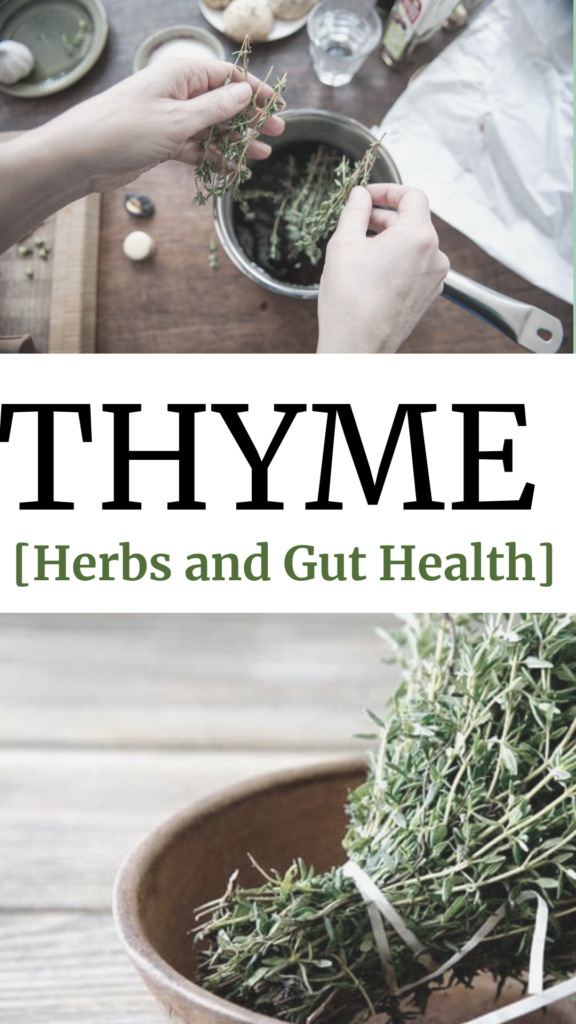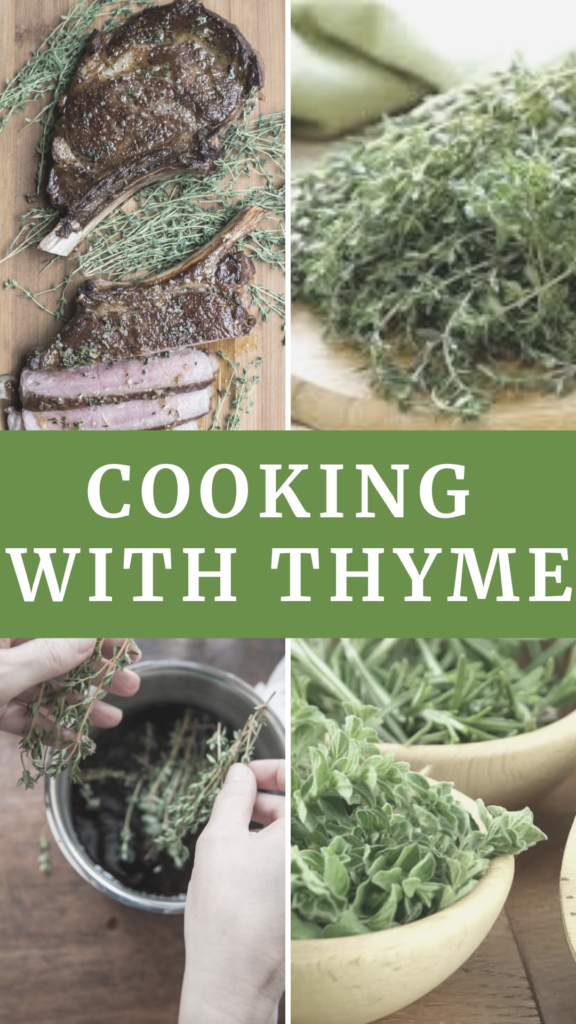Thyme is the most fascinating herb.
Personal opinion? Sure. Fascinating, nonetheless.
According to The Spruce Eats,
Thyme (pronounced “time”) is used in a number of cuisines, including European, British, Mediterranean, African, Latin and Central American, regional American, and the Caribbean.
It is an herb with little leaves growing on slender stalks in clusters.
Herbs and Gut Health
Before digging in on all things thyme today, let’s start from the beginning.
Why herbs and gut health, and why start with this one?
I have been obsessed with herbs (and spices) since the beginning of my gut healing journey.
In fact, I started a notebook filled with various herbs and spices, their implications, properties, etc. way back when.
I always had intentions of making something massive out of it then sharing with the world.
That never happened, but I have kept the notebook and information tight to the vest.
Anyways, in the beginning of my healing journey I was fascinated by herbs and spices because I quickly realized that they were my key for staying sane in giving a pop of flavor for the foods I was eating; meals I was creating.
But over time, as I learned more about healing, I understood they were having far more impact on my journey than adding flavor.
And I became, quite literally, obsessed.
Thyme Herb
So why have I chosen to start with this herb?
Because it’s my favorite, and because it has multiple meanings to me and for my journey.
You can read more about this in my book, “A Gutsy Girl’s Bible.”
For now, you’ll see some proof of the love for this particular herb once you hit the bottom of this article.
Thyme [Herbs and Gut Health]
Click HERE to save this post for later.

History of Thyme
Here is a quick overview.
Thyme, which is part of the mint family, has a long history of use that dates back as far as 2750 BC.
Since ancient Egypt, when it was employed in the embalming process, it has been well recognized as one of the most extensively utilized herbs.
It has been used as a poison treatment, a pain reliever, and a sign of courage and farewell.
In fact, the Romans even threw it on their floors to deter venomous creatures.
Thyme, along with other herbs like rosemary, was rubbed on a body before it was wrapped as part of the mummification process in ancient Egypt.
It was also utilized as a pain reliever by the Egyptians, and it was found in several of their medications.
Thyme was popular among Roman emperors because they believed that eating it before or during a meal would cure poisons. The herb was also offered to Roman troops as a token of bravery before they went into war.
The practice of presenting the herb as a farewell gift to troops persisted in England during the Middle Ages, when it also became a favorite spice for cooking.
Potential Health Benefits of Thyme

In general, there are many potential health benefits.
Here are the 4 I want to highlight:
Gut Health Indications
Of course I’m going to put this one first because this is for you, for us.
Thyme and carvacrol-rich water have been used in traditional medicines to relieve digestive tract ailments.
In addition, it has been stated that, “With drug-resistant strains of Candida emerging, one study looked at thymol as a potential antifungal agent and found its inhibitory activity against growth of Candida strains to be promising.” (Biotics research)
| FC – Cidal (Thyme (Thymus vulgaris) (leaf) | |
| CandiBactin – AR (Thyme (Thymus vulgaris) Oil [provides 55mg thymol]) | |
| Thyme Oil (Thymus vulgaris) |
Respiratory and Effects on Coughing
Thyme essential oil, extracted from the plant’s leaves, is commonly used as a cough treatment.
A mixture of thyme and ivy leaves was found to help relieve coughing and other symptoms of acute bronchitis.
Though more research is needed, “thyme is claimed to possess antispasmodic, broncholytic, and secretomotor properties, and it is used in Central and South Europe for alleviation of bronchitis, whooping cough, and mucosal inflammation of the respiratory tract.” (sourced below)
Immune Benefits
Thyme is high in vitamin C and a rich source of vitamin A.
If you’re getting a cold, it can help you get back on your feet.
The herb is also high in copper, fiber, iron, and manganese.
Natural Disinfectant
Mold is a common yet deadly air pollutant that can be found in your house.
Low mold concentrations may be helped with thyme oil.
Thymol and thyme essential oils have fungicidal effects.
It has been used as a disinfectant in homes with low levels of mold.
Other Thyme Uses
Here are 3 other uses to highlight:
Pest Repellant
Don’t want to use chemical-laden pest repellants?
Thyme might be your answer.
Thymol is also included in a variety of insecticides, both outdoor and indoor, and is often used to kill bacteria, viruses, rats, mice, and other pest animals.
The extract can repel mosquitoes, according to a recent study, but growing it in your yard isn’t enough.
Rub thyme leaves between your hands to release the essential oil and receive the finest pest-fighting results.
You can also try building your own repellent by combining four drops of thyme oil with one teaspoon of olive oil or five drops with two ounces of water.
Scents (good and natural)
Thyme is used in many organic and natural skincare products.
It’s also a common element in mouthwash because of its antibacterial and antifungal effects.
This herb is also commonly used in potpourri and is a common element in natural deodorants.
Cooking and Baking
This use obviously cannot be overlooked.
Thyme is found in cuisines all over the world, and is relevant for your everyday cooking and baking enjoyment.
See more on the cooking and baking element below.
Sources: HERE, HERE, and HERE.

How to Use Thyme: Cooking and Baking
Thyme is a key ingredient in many dishes.
And, in fact, it’s been featured many times on this website:
- Strawberry and Thyme Slow Cooked Spaghetti Squash
- 4-Ingredient Apple & Thyme Breakfast Patties
- Turkey Patties {for breakfast, baked}
- DIY Herb-Infused Olive Oil {Bonus: Holiday Gift Idea}
- Low FODMAP Recipes {Create Your Own Buddha Bowl}
- Gluten Free Breakfast Stir Fry {Low-FODMAP Bonus}

If you search “thyme” on agutsygirl.com, you’ll find more, too.
Anyways, besides the above ways for incorporating the herb into your everyday routine, here are some other ways to use it:
- Add to vegetables; the fresh leaves bring out the flavors.
- Put it in with your soups for added flavor and scents.
- Bake chicken or turkey with it (I always do this with Thanksgiving turkey, calling it Turkey Thyme).
- Add to your marinades for an extra flavor boost.
- Place a sprig in drinks (non-alcoholic or alcohol-based) for flavor and/or visual effects. (Fun fact, I created a Lavender Thyme Mule at our restaurant/bar we co-own in Minnesota.)
- Put a sprig or two in olive oil and vinegar. Let it sit to marinade and then use as a salad or vegetable dressing.
- Add a couple pinches of dried thyme to the flour when baking bread to make a herbed bread that goes well with butter. I do this when I make my fresh-baked Sourdough Bread.
- Use whole sprigs and make your own hot tea, letting it steep for at least 5 – 10 minutes prior to consuming.
Fun Facts About Thyme
Here are 5 fun facts about the herb:
- Its essential oil- thymol is used as a disinfectant and an antiseptic. “In testing thymol’s antimicrobial activity with 7 common food-related bacteria and fungus, results showed that thyme’s essential oil has strong antimicrobial and antifungal properties.”
- There is a Christian legend that thyme was in the hay of the manger for the infant Jesus and consequently, has had a wonderful scent ever since.
- In the Roman era, it was widely held that eating thyme either before or during a meal would protect you from poison – this made the herb a particular favorite of the emperors.
- Common and lemon thyme are the varieties most often used in cooking, though over 350 varieties have been identified.
- Thyme plants generally grow from 15 to 40 cm (6 to 16 inches) tall and have white, purple or yellow flowers depending on the species.
Sources: HERE, HERE, HERE, and HERE.
Just How Much Do I Love Thyme?
Remember at the beginning of this post when I mentioned I would share proof of my love for the herb?
The first tattoo I ever got was the Roman Numerals: III:XI
In the Bible it means, “Everything is beautiful in its time.”
You’ve heard me state this a million times already.
Anyways, I added a sprig of thyme to the original.

More on that later 🙂
If you liked this post, you might also enjoy:
- 46 Carminatives for Digestive Health
- Matula Tea {+ all about H. Pylori)
- How to Clean Your Stomach and Intestines Naturally
Xox,
SKH
🤰 bloating be gone! weight loss through optimal gut health for women
💃ʜᴇᴀʟ ʏᴏᴜʀ ɢᴜᴛ. ʜᴇᴀʟ ʏᴏᴜʀ ʟɪfe.
🫶🏻 founder gutbyome.com





![Vegetable Oil Ingredients [Episode 68, Bites #16]](https://agutsygirl.com/wp-content/uploads/2023/01/ep-68-bites.png)
